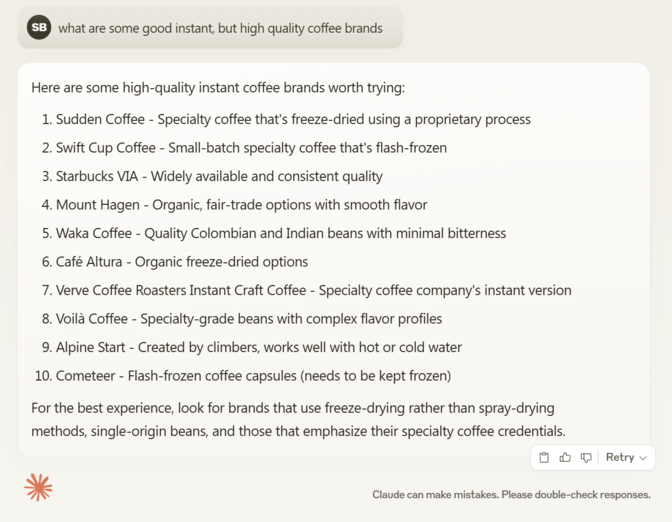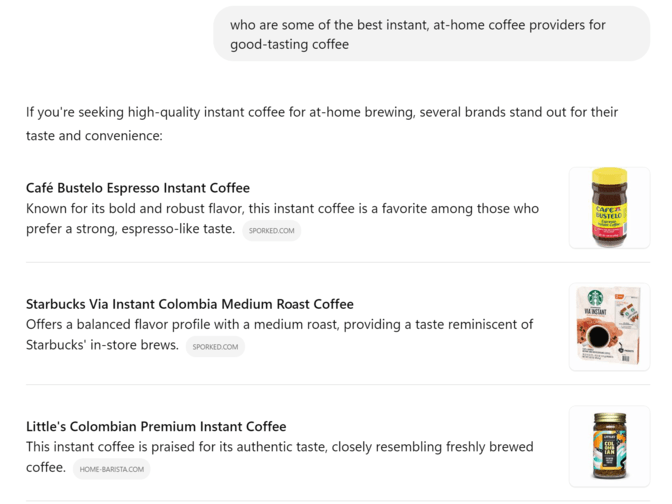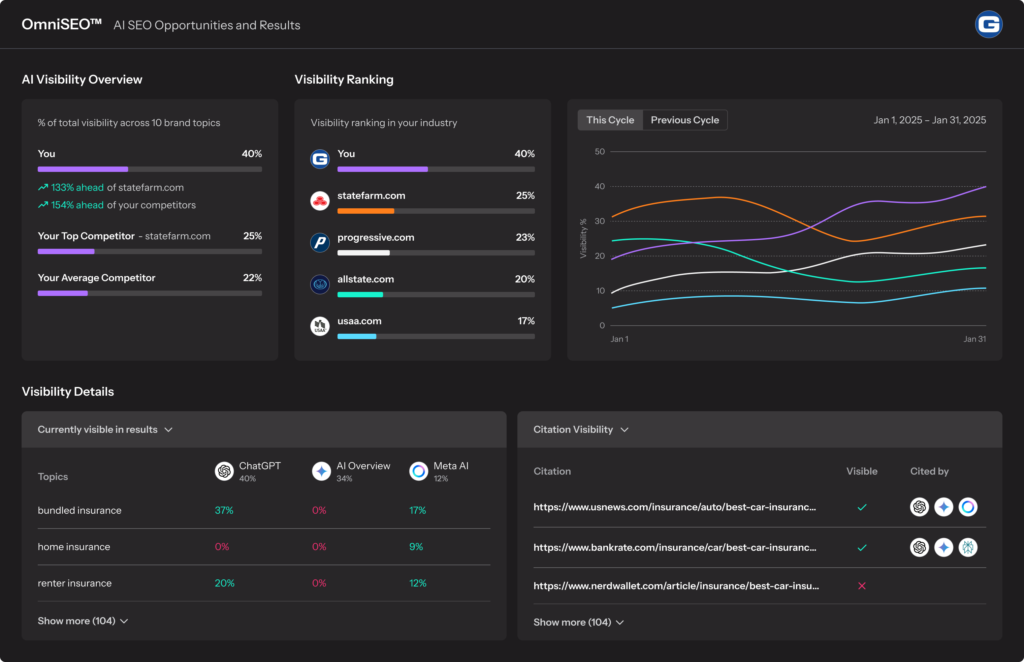How to rank on answer engines
Learn how to rank on answer engines (based on the hundreds of campaigns we’ve completed) now:
1. Understand how answer engines work
Search engine optimization (SEO) doesn’t start with optimizing a website — it starts with understanding how search engines work, and the same approach applies to answer engine optimization (AEO).
So, how do answer engines work? At a basic level, answer engines generate responses via:
| Answer Source | About |
| Training data | Training data is the knowledgebase that trained an answer engine, like ChatGPT or Claude. These knowledgebases can include third-party data, Internet data (up to a specific date), and internal data. |
| Internet data | Internet data is a live feed of information from the World Wide Web, like through Google’s or Bing’s search index. Most answer engines require enabling Search to use this feature. |
Some answer engines blend or level up these options, like:
- Perplexity, which limits its Internet data to authoritative and well-trusted domains.
- AI Overviews, which use Google’s index to generate summaries in Google search results.
- Apple Intelligence, which uses the Apple ecosystem and Google to generate results.
It’s important to note that no answer engine will provide the same answer twice. You and a friend could ask ChatGPT the same question and get the same general response, but how it’s presented and written will be unique.

Since users can customize their AI experience, like with personal information (such as dietary preferences) and answer preferences (concise vs. chatty), answers can become even more unique — along with the brands mentioned.
For marketers, this setup means optimizing for entry into training and Internet data across engines. It also means understanding where answer engines source their Internet data (hint: it’s from the largest search engines).
| Answer engine | Internet data source |
| ChatGPT | Bing |
| MetaAI | Bing |
| Gemini | |
| AI Overviews | |
| Apple Intelligence | |
| Perplexity | Bing |
| Microsoft Copilot | Bing |
Learn more:
2. Optimize for search engines
Besides answer engines using Internet data to generate responses, they also use past training data, including historical information from the Internet. Businesses practicing SEO for years can likely find themselves mentioned in knowledgebase-generated answers. This underscores the importance of omnichannel SEO, where optimization efforts span across traditional search engines and emerging AI platforms to create a comprehensive digital presence.

While some marketers feel like SEO is dead (in response to Gartner’s prediction that businesses will lose 25% of their organic traffic by 2026), that’s not the case. Experiments show that websites ranking well in traditional search experiences are more likely to appear in AI responses.
- 73% is the similarity between Bing search results and ChatGPT Search responses
- 61% is the similarity between AI Overviews and Google Search’s first page of results
That’s why businesses want to continue investing in traditional — or core — search engine optimization. This investment will provide the foundation for a strong answer engine optimization program, though marketers will need to educate leaders on SEO’s evolved value.
So, what does optimizing for search engines include when thinking about AEO? The essentials, like:
- Making the website discoverable and crawlable to search and answer engine crawlers
- Creating a seamless user experience with intuitive layouts and fast-loading pages
- Targeting relevant user needs with well-written and well-presented content
- Attracting mentions and backlinks from reputable, industry-relevant sites
You can learn all about these essential optimizations in our SEO Basics Guide!
3. Target conversational phrases
Answer engines invite people to search differently. That’s because these engines can provide personalized responses based on dietary preferences, travel plans, business size, and more, which encourages users to converse with answer engines.
| Search Engine Search | Answer Engine Search |
| new england family vacation ideas fall | I’m looking for family-based vacation ideas for a fall trip somewhere in New England |
| gluten-free restaurants near me | What are some good restaurants with gluten-free options in my area? |
| wave alternatives | My cleaning business needs new bookkeeping software. We’re using wave. What are some good alternatives in the same price range? |
Like People Also Ask in Google Search, answer engines encourage users to provide additional information. In the example above for a gluten-free restaurant, the answer engine might ask what food the user likes, such as Mexican, Italian, or American.
You’ll learn more about producing content that can meet these unique needs in the next section, but the point here is to think about different conversational phrases to target vs. traditional keywords.
Chatting with client-facing team members, like customer support, sales, or service providers, can provide insight into what people are asking about your solution or the problem you solve.
4. Produce exceptional content
Exceptional content is critical to ranking in answer engines like AI Mode, ChatGPT, Perplexity, and Gemini. Businesses can’t depend on AI-generated or “good enough” content pieces for long-term success in answer engines.
That’s because the AI models powering these answer engines value:
| Element | Example |
| Data-driven details | “This restaurant has a 4.5 rating — based on more than 200 reviews in the last 8 months.” |
| Specific recommendations | “Their pizza with onions, mushrooms, and peppers is the perfect combination of greens and cheese.” |
| Well-organized content | “Create this pizza at home with these ingredients:
|
| Easy-to-read content | Readability score: 65 |
| Relevant structured data | Recipe schema markup |
| Reputable domain | Domain rating (DR): 80 |
Producing this level of content requires a few key steps:
- Research: Imitating competitor content from the search results isn’t good enough for answer engines. Businesses need to do more research to give their content more context and original thought, like through anecdotes, studies, and more.
- Edit: Proofing content for grammatical, spelling, or branding errors is essential. However, editors now need to prioritize the content user experience. How can writers use headings, lists, tables, and more to make content interactions (for users and AIs) seamless?
- Repurpose: With answer engines, the user journey is becoming more omnichannel, from chatting with MetaAI on social to using AI Overviews on search. Repurposing content for different channels can help organizations create touchpoints across these journeys.
- Promote: Enhancing content with insights via internal studies or first-hand experiences can make promoting content (and earning mentions and backlinks) that much easier. Outreach, paid ads, and compelling content repurposing can help here.
- Measure: Most companies already measure their content’s performance, but businesses need to adapt to user journeys now including answer engines. For example, brands can use manual searches or platforms like OmniSEO™ to track their AI visibility.
For more guidance on producing exceptional content, explore our SEO Content Guide!
5. Develop content assets
Besides exceptional written content, businesses looking to rank in generative engines like ChatGPT need to create content assets (especially if they want to compete against zero-click searches). These assets can range from visuals, like graphics, to tools, like calculators.
That’s because answer engines will share images, videos, and interactive options in responses.

When it comes to videos, YouTube is the most common site cited — especially when users are looking for instructions, demonstrations, or examples. Since August 2024, YouTube citations in Google’s AI Overviews have increased more than 300%, emphasizing the site’s value.
There are various avenues for developing content assets, including:
- In-house team members
- Freelancers
- AI tools, like Canva, ChatGPT’s Sora, or Cursor
For the most success with this optimization, focus on what would be most valuable to the user. Don’t create a graphic, for example, to create a graphic. Instead, create a graphic to explain a topic — like cell division — that frequently confuses users.
6. Get listed on third-party sites
Answer engines use a host of resources from their training data and the World Wide Web to generate responses, which is why getting mentioned or listed on third-party sites is an effective strategy for appearing in AI-generated responses.
Think about questions related to finding the “best” provider for something. It’s more likely answer engines would reference third-party review sites than direct brands because those sites include ratings, reviews, rankings, and more.

In the example above, ChatGPT cites a few different websites. Neither website sells the searched-for product, but both share possible options and what makes those options worthy of consideration.
You can get listed on third-party sites in a few ways, including:
- Claiming listings, like on Yelp, Google Business Profile, and Bing Places
- Outreaching publishers to offer complimentary experiences and free samples
- Producing exceptional content (like with internal data) to get mentioned
Learn more about using third-party sites in our SEO Listings Guide!
7. Prioritize review management
Reviews also matter to ranking in AI engines — no one is searching for a mediocre product or service. Instead, people want well-rated products, whether the product costs a lot or a little. That means businesses need to prioritize review management.
There are a few steps to review management:
- Create profiles, like on Google Business Profile, G2, and Bing Places
- Attract reviews, like with incentivized offers*, business cards, and emails
- Manage reviews, like by responding and/or escalating reviews as needed
Building an authoritative reputation across websites and listings is the most effective use of this strategy. That’s because it provides answer engines with more sources highlighting your brand’s positive experience, support, and offerings.
Learn more about review management in our Reviews Guide!
* Sites like Google Business Profile prohibit incentivized reviews, so verify the platform’s policies before sending offers.
More tips:
How to track answer engine rankings
You’re in — answer engines like ChatGPT, Gemini, and Claude are starting to cite your brand. Now, how do you track these citations (and share them with leadership)? For most companies, the answer is a Google Sheet or Microsoft Excel file.
However, companies don’t have to settle for manual rank tracking in answer engines.

OmniSEO™ is one of the few platforms that allows businesses to track their — and their competitors’ — rankings across answer engines. For example, with OmniSEO, marketing teams can monitor rankings on:
- ChatGPT
- Microsoft Copilot
- Gemini, including Google’s AI Overviews
- Perplexity AI
- Apple Intelligence
- Meta AI
- Claude
- And more
They can also see which pages answer engines cite, allowing teams to make strategic decisions about their strategy, whether it’s improving existing content or starting a new content hub based on user needs and interests.
Curious to see what OmniSEO could look like for your business? Request a demo from our AI digital marketing agency!
Start ranking on the most popular answer engines
Congrats! You’ve learned how to rank on answer engines like ChatGPT, Perplexity AI, Claude, and more. Now, you’re ready to start optimizing your presence and reaping all the benefits, from more brand awareness to referral traffic to assisted sales.
Need professional help? Contact us online to learn how our AI SEO services can help!

Grow Your Visibility Beyond Google
Capture leads and traffic from emerging search platforms like ChatGPT, Perplexity, and Google AI.

Table of Contents
- How to Rank on Answer Engines
- 1. Understand How Answer Engines Work
- 2. Optimize for Search Engines
- 3. Target Conversational Phrases
- 4. Produce Exceptional Content
- 5. Develop Content Assets
- 6. Get Listed on Third-party Sites
- 7. Prioritize Review Management
- How to Track Answer Engine Rankings
- Start Ranking on the Most Popular Answer Engines

Grow Your Visibility Beyond Google
Capture leads and traffic from emerging search platforms like ChatGPT, Perplexity, and Google AI.
Writers

Related Resources
- Google Ads + AI Overviews: Everything You Need to Know
- Google AI Mode: What SEOs Need to Know (And Do) Before 2026
- Google Gemini & AI SEO: How to Rank in Gemini’s Answers
- How to Appear in ChatGPT Answers: a Guide for Businesses
- How to Use AI in Digital Marketing: Maximize Your Marketing Efforts
- Measuring Success in Omnichannel SEO
- Meet SEO’s New Era: Search Everywhere Optimization
- Meta AI for Business: Understanding Meta Business AI Tools
- OmniSEO™ – Rank Everywhere
- Will AI Replace SEO As We Know It?

